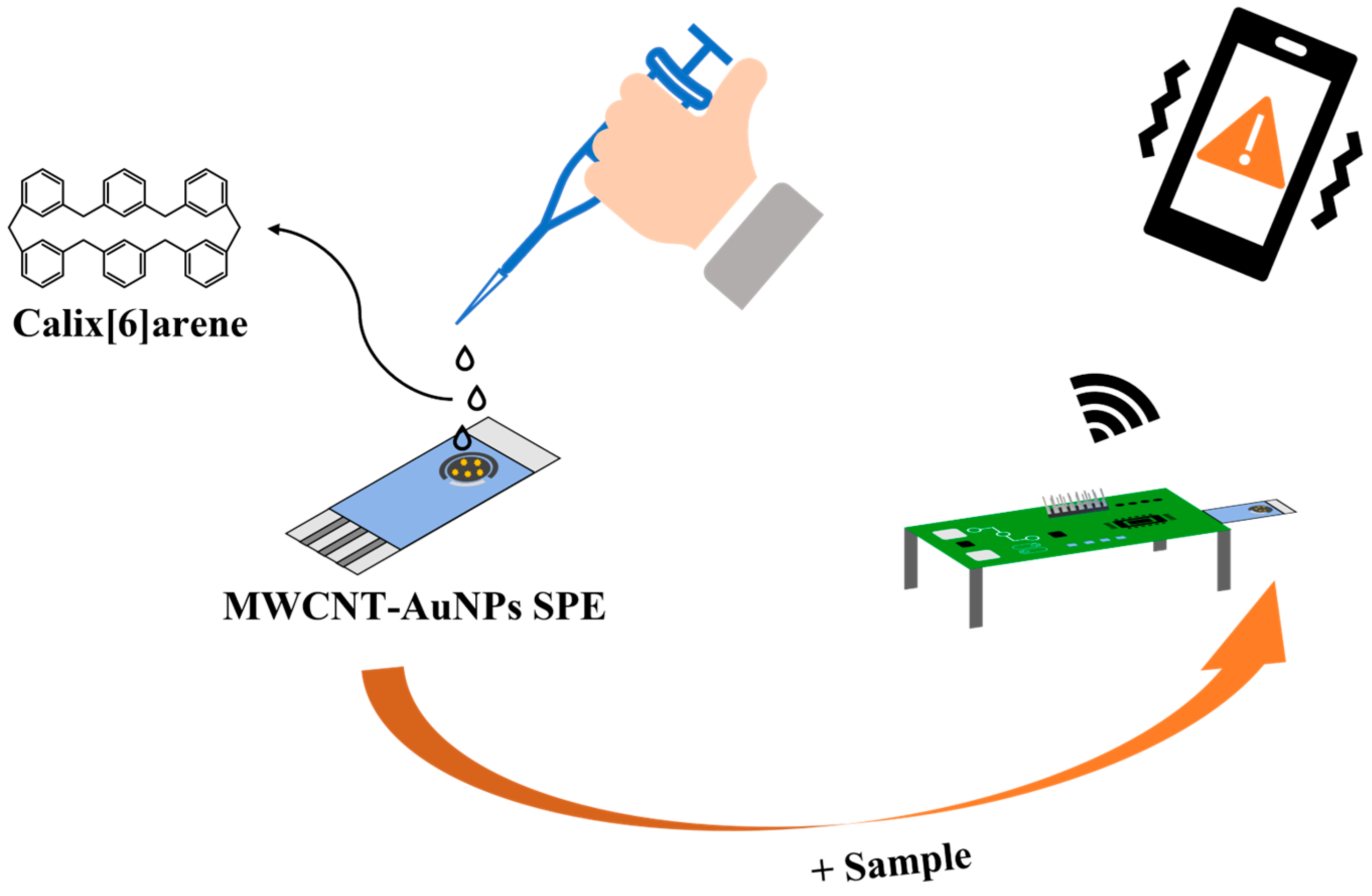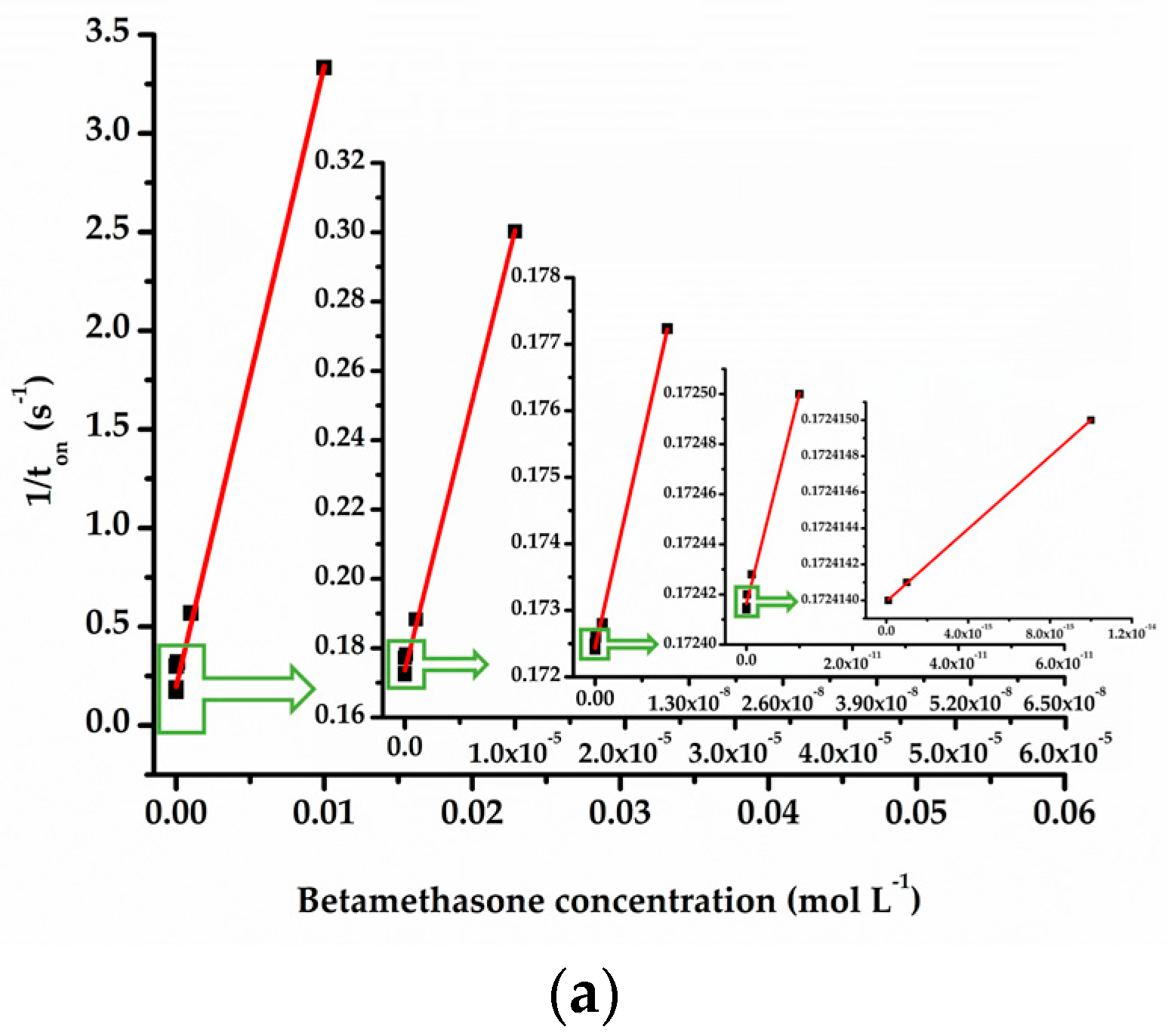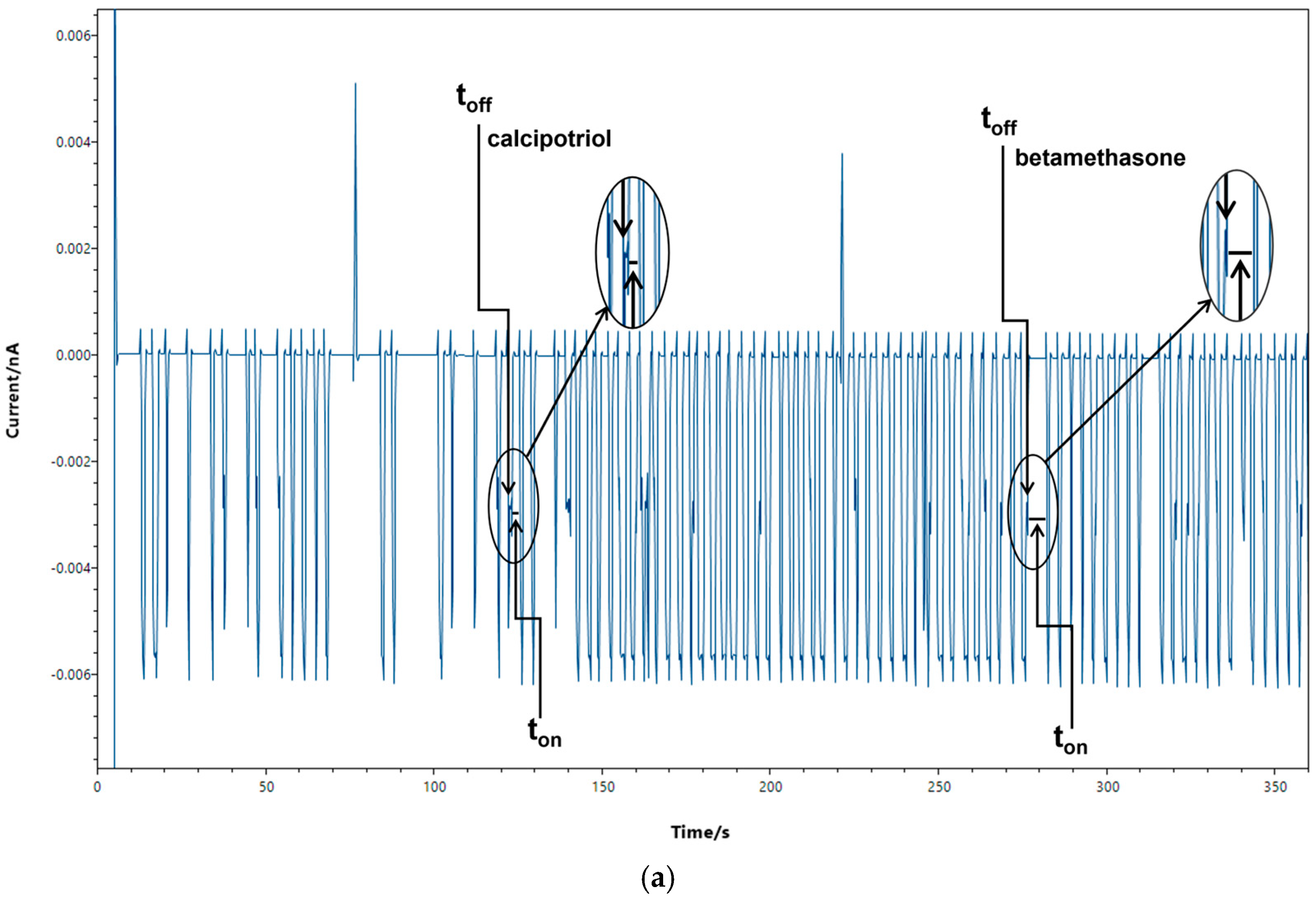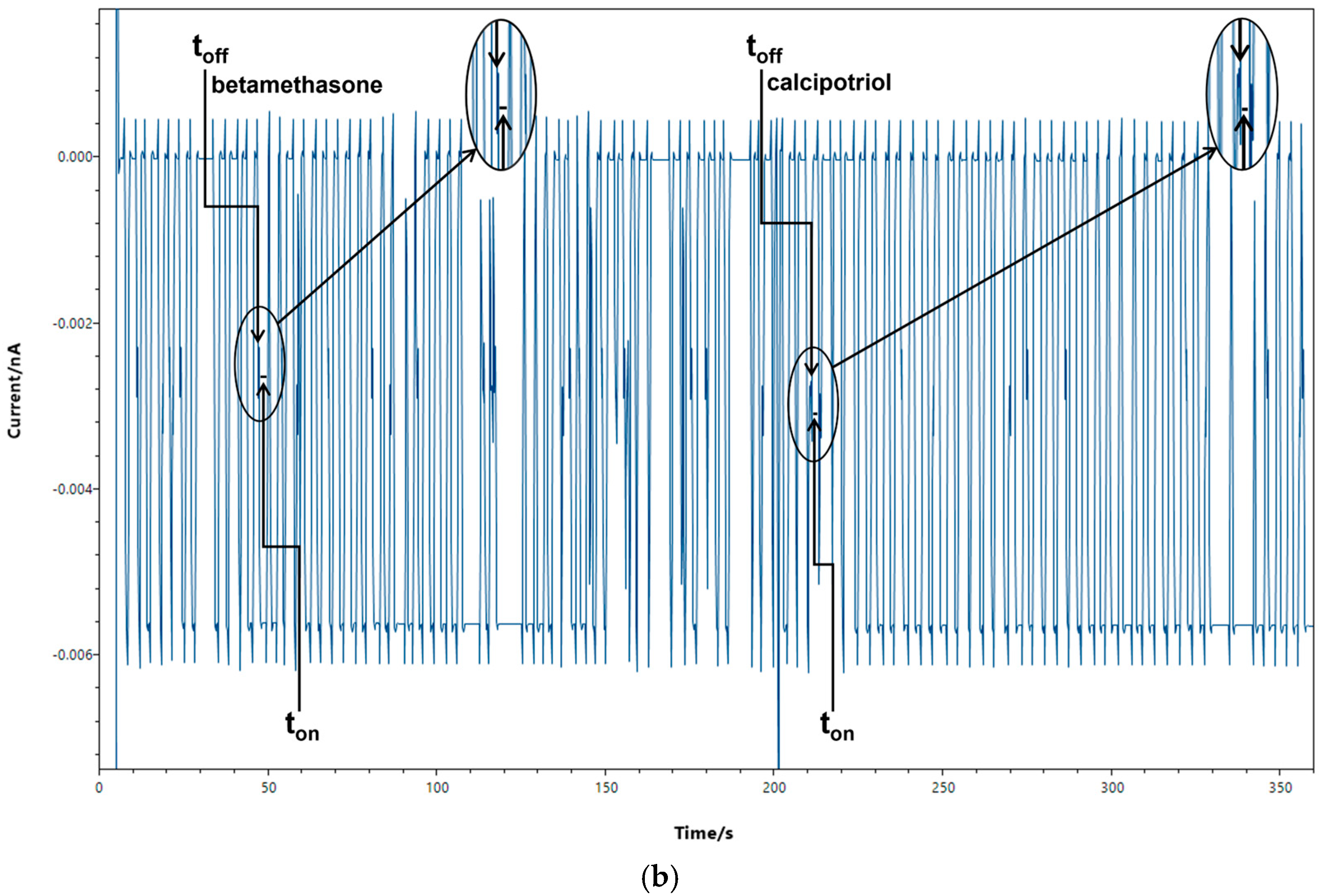Disposable Stochastic Platform for the Simultaneous Determination of Calcipotriol and Betamethasone in Pharmaceutical and Surface Water Samples
Abstract
:1. Introduction
2. Materials and Methods
2.1. Materials and Reagents
2.2. Apparatus and Methods
2.3. Design of the C6A/MWCNT-GNP SCPE Disposable Platform
2.4. Stochastic Mode
2.5. Samples
3. Results
3.1. Response Characteristics of the C6A/MWCNT-AuNPs SPE Disposable Platform in the Stochastic Mode
3.2. Selectivity of C6A/MWCNT-AuNPs SPE Disposable Stochastic Platform
3.3. Reproducibility and Stability of C6A/MWCNT-AuNPs SPE Disposable Stochastic Platform
3.4. Simultaneous Determination of Calcipotriol and Betamethasone from Real Samples Using C6A/MWCNT-AuNPs SPE Disposable Stochastic Platform
4. Conclusions
Author Contributions
Funding
Data Availability Statement
Conflicts of Interest
References
- Griffiths, C.E.M.; Christophers, E.; Barker, J.N.W.N.; Chalmers, R.J.G.; Chimenti, S.; Krueger, G.G.; Leonardi, C.; Menter, A.; Ortonne, J.P.; Fry, L. A Classification of Psoriasis Vulgaris According to Phenotype. Br. J. Dermatol. 2007, 156, 258–262. [Google Scholar] [CrossRef]
- Fenton, C.; Plosker, G.L. Calcipotriol/Betamethasone Dipropionate A Review of Its Use in the Treatment of Psoriasis Vulgaris. Am. J. Clin. Dermatol. 2004, 5, 463–478. [Google Scholar] [CrossRef]
- Murphy, G.; Reich, K. In Touch with Psoriasis: Topical Treatments and Current Guidelines. J. Eur. Acad. Dermatol. Venereol. 2011, 25, 3–8. [Google Scholar] [CrossRef]
- Mccormack Adis, P.L. Calcipotriol/Betamethasone Dipropionate a Review of Its Use in the Treatment of Psoriasis Vulgaris of the Trunk, Limbs and Scalp. Drugs 2011, 71, 709–730. [Google Scholar] [CrossRef] [PubMed]
- Hamilton, C.M.; Winter, M.J.; Margiotta-Casaluci, L.; Owen, S.F.; Tyler, C.R. Are Synthetic Glucocorticoids in the Aquatic Environment a Risk to Fish? Environ. Int. 2022, 162, 107163. [Google Scholar] [CrossRef] [PubMed]
- Council of Europe. European Pharmacopoeia Commission; European Directorate for the Quality of Medicines & Healthcare European Pharmacopoeia, 10th ed.; Council of Europe: Strasbourg, France, 2017; Volume 1. [Google Scholar]
- Hassib, S.T.; Mahrouse, M.A.; Elkady, E.F.; Sayed, R.M. Simultaneous HPLC Determination of Betamethasone Esters-Containing Mixtures: Analysis of Their Topical Preparations. J. Chromatogr. Sci. 2018, 56, 716–723. [Google Scholar] [CrossRef]
- Merey, H.A.; El-Mosallamy, S.S.; Hassan, N.Y.; El-Zeany, B.A. Validated Chromatographic Methods for Simultaneous Determination of Calcipotriol Monohydrate and Betamethasone Dipropionate in the Presence of Two Dosage Form Additives. J. Chromatogr. Sci. 2019, 57, 305–311. [Google Scholar] [CrossRef]
- Kannaiah, K.P.; Sugumaran, A. Environmental Benign Analytical Quality by Design and UPLC Method Development for Betamethasone and Calcipotriene in Ointment. J. Taibah Univ. Sci. 2021, 15, 1156–1167. [Google Scholar] [CrossRef]
- Raeis Farshid, B.; Sohrabi, M.R.; Davallo, M.; Raeis Farshid, S. Green Spectrophotometric Method for the Spectral Pattern Recognition Based on Fuzzy Inference System Compared to Continuous Wavelet Transform for the Quantitative Determination of Anti-Psoriasis Drugs in Commercial Skin Ointment Formulation: Comparison with HPLC. Sustain. Chem. Pharm. 2023, 33, 101107. [Google Scholar] [CrossRef]
- Bayley, H.; Cremer, P.S. Stochastic Sensors Inspired by Biology. Nature 2001, 413, 226–230. [Google Scholar] [CrossRef]
- Dinu Gugoasa, L.A.; Stefan-van Staden, R.-I.; van Staden, F.J.; Coros, M.; Pruneanu, S.M. Myoglobin-Silver Reduced Graphene Oxide Nanocomposite Stochastic Biosensor for the Determination of Luteinizing Hormone and Follicle-Stimulating Hormone from Saliva Samples. Anal. Bioanal. Chem. 2020, 412, 5191–5202. [Google Scholar] [CrossRef] [PubMed]
- Stefan-van Staden, R.I.; Musat, O.R.; Gheorghe, D.C.; Ilie-Mihai, R.M.; Cioates Negut, C.; Sfirloaga, P. Ultrasensitive Assay of HER1, HER2, and Heregulin-α in Whole Blood. Talanta Open 2022, 6, 100151. [Google Scholar] [CrossRef]
- Stefan-van Staden, R.I.; Bogea, I.M.; Ilie-Mihai, R.M.; Gheorghe, D.C.; Coroş, M.; Pruneanu, S.M. Stochastic Microsensors Based on Modified Graphene for Pattern Recognition of Maspin in Biological Samples. Anal. Bioanal. Chem. 2022, 414, 3667–3673. [Google Scholar] [CrossRef] [PubMed]
- Stefan-van Staden, R.-I.; Moscalu-Lungu, A.; van Staden, J.F. Nanostructured Materials Used for Pattern Recognition of Bisphenols in Waste Water Samples. J. Electrochem. Soc. 2019, 166, B903–B907. [Google Scholar] [CrossRef]
- Stefan-van Staden, R.I.; Chera-Anghel, I.A.; Gheorghe, D.C.; van Staden, J.F.; Badulescu, M. Smart Portable Device Based on the Utilization of a 2D Disposable Paper Stochastic Sensor for Fast Ultrasensitive Screening of Food Samples for Bisphenols. Sensors 2023, 23, 314. [Google Scholar] [CrossRef]
- Stefan-van Staden, R.I.; Bogea, M.I.; Ilie-Mihai, R.M.; Gheorghe, D.C.; Aboul-Enein, H.Y.; Coros, M.; Pruneanu, S.M. N,S-Decorated Graphenes Modified with 2,3,7,8,12,13,17,18-Octaethyl-21H,23H-Porphine Manganese(III) Chloride-Based 3D Needle Stochastic Sensors for Enantioanalysis of Arginine: A Key Factor in the Metabolomics and Early Detection of Gastric Cancer. Anal. Bioanal. Chem. 2022, 414, 6521–6530. [Google Scholar] [CrossRef]
- Georgescu State, R.; van Staden, J.F.; Stefan-van Staden, R.I.; State, R.N. Electrochemical Platform Based on Molecularly Imprinted Polymer with Zinc Oxide Nanoparticles and Multiwalled Carbon Nanotubes Modified Screen-Printed Carbon Electrode for Amaranth Determination. Microchim. Acta 2023, 190, 229. [Google Scholar] [CrossRef]
- Norizan, M.N.; Moklis, M.H.; Ngah Demon, S.Z.; Halim, N.A.; Samsuri, A.; Mohamad, I.S.; Knight, V.F.; Abdullah, N. Carbon Nanotubes: Functionalisation and Their Application in Chemical Sensors. RSC Adv. 2020, 10, 43704–43732. [Google Scholar] [CrossRef]
- Georgescu State, R.; van Staden, J.F.; State, R.N.; Papa, F. Rapid and Sensitive Electrochemical Determination of Tartrazine in Commercial Food Samples Using IL/AuTiO2/GO Composite Modified Carbon Paste Electrode. Food. Chem. 2022, 385, 132616. [Google Scholar] [CrossRef]
- Stefanov, C.; Cioates Negut, C.; Dinu Gugoasa, L.A.; van Staden, J.F. Gold Nanoparticle-Graphene Quantum Dots Nanozyme for the Wide Range and Sensitive Electrochemical Determination of Quercetin in Plasma Droplets. Microchim. Acta 2020, 187, 611. [Google Scholar] [CrossRef]
- Afkhami, A.; Bahiraei, A.; Madrakian, T. Gold Nanoparticle/Multi-Walled Carbon Nanotube Modified Glassy Carbon Electrode as a Sensitive Voltammetric Sensor for the Determination of Diclofenac Sodium. Mater. Sci. Eng. C 2016, 59, 168–176. [Google Scholar] [CrossRef] [PubMed]
- Shinkai, S.; Araki, K.; Manabe, O. Does the Calixarene Cavity Recognise the Size of Guest Molecules? On the “hole-Size Selectivity” in Water-Soluble Calixarenes. J. Chem. Soc. Chem. Commun. 1988, 187–189. [Google Scholar] [CrossRef]
- Goyal, R.N.; Bishnoi, S.; Raj, A.; Rana, S. A Sensitive Voltammetric Sensor for Detecting Betamethasone in Biological Fluids. Comb. Chem. High Throughput Screen. 2010, 13, 610–618. [Google Scholar] [CrossRef] [PubMed]
- Goyal, R.N.; Bishnoi, S. Effect of Single Walled Carbon Nanotube-Cetyltrimethyl Ammonium Bromide Nanocomposite Film Modified Pyrolytic Graphite on the Determination of Betamethasone in Human Urine. Colloids. Surf. B Biointerfaces 2010, 77, 200–205. [Google Scholar] [CrossRef]
- Smajdor, J.; Paczosa-Bator, B.; Baś, B.; Piech, R. High Sensitive Voltammetric Determination of Betamethasone on an Amalgam Film Electrode. J. Electrochem. Soc. 2018, 165, H646–H651. [Google Scholar] [CrossRef]
- Hibbert, D.B.; Korte, E.H.; Örnemark, U. IUPAC Recommendations. Metrological and quality concepts in analytical chemistry (IUPAC Recommendations 2021). Pure Appl. Chem. 2021, 93, 997–1048. [Google Scholar] [CrossRef]






| Calibration Equation; Correlation Coefficient (r) | Linear Concentration Range (mol L−1) | toff (s) | Sensitivity (mol L−1 s−1) | LOQ (mol L−1) |
|---|---|---|---|---|
| Calcipotriol | ||||
| 1/ton = 0.04 (±0.01) + 5.86 (±0.03) × 108 × Ccalcipotriol r = 0.9999 | 1.0 × 10−15–1.0 × 10−3 | 2.2 ± 0.1 | 5.86 (±0.03) × 108 | 1.0 × 10−15 |
| Betamethasone | ||||
| 1/ton = 0.07 (±0.01) + 3.25 (±0.02) × 109 × Cbetamethasone r = 0.9992 | 1.0 × 10−16–1.0 × 10−2 | 0.7 ± 0.1 | 3.25 (±0.02) × 109 | 1.0 × 10−16 |
| Method | Analyte | Linear Concentration Range (mol L−1) | LOQ (mol L−1) | Ref. |
|---|---|---|---|---|
| HPLC with UV detection | Calcipotriol | 2.42 × 10−6–4.85 × 10−5 | 2.9 × 10−7 | [7] |
| Betamethasone | 9.91 × 10−7–3.96 × 10−4 | 7.96 × 10−7 | ||
| UPLC with UV detection | Calcipotriol | 3.03 × 10−5–1.82 × 10−4 | 2.37 × 10−5 | [9] |
| Betamethasone | 3.15 × 10−4–1.91 × 10−3 | 9.64 × 10−5 | ||
| UV spectrophotometry with FIS and CWT | Calcipotriol | 2.42 × 10−6–2.42 × 10−5 | 5.45 × 10−8 | [10] |
| Betamethasone | 1.98 × 10−6–1.98 × 10−5 | 5.49 × 10−8 | ||
| Stochastic using C6A/MWCNT-AuNPs SPE disposable platform | Calcipotriol | 1.0 × 10−15–1.0 × 10−3 | 1.0 × 10−15 | This work |
| Betamethasone | 1.0 × 10−16–1.0 × 10−2 | 1.0 × 10−16 |
| Electrochemical Method | Sensor | Linear Concentration Range (mol L−1) | LOQ (mol L−1) | Ref. |
|---|---|---|---|---|
| SWV | SWNT/EPPGE | 1.0 × 10−9–2.5 × 10−8 | 1.0 × 10−9 | [24] |
| SWV | SWNTs–CTAB/EPPGE | 0.5 × 10−9–1.0 × 10−7 | 0.86 × 10−9 | [25] |
| DPV | Hg(Ag)FE | 5.0 × 10−9–0.8 × 10−6 | 5.0 × 10−9 | [26] |
| Stochastic | C6A/MWCNT-AuNPs SPE disposable platform | 1.0 × 10−16–1.0 × 10−2 | 1.0 × 10−16 | This work |
| Sample | Calcipotriol and Betamethasone, Added Amount (mol L−1) | Recovery (%) | |
|---|---|---|---|
| Calcipotriol | Betamethasone | ||
| Topical pharmaceutical gel | − | 99.15 ± 0.03 | 99.93 ± 0.02 |
| Surface water samples | 1.0 × 10−4 | 99.21 ± 0.03 | 99.47 ± 0.04 |
| 1.0 × 10−6 | 99.50 ± 0.05 | 99.30 ± 0.02 | |
| 1.0 × 10−8 | 99.21 ± 0.03 | 99.47 ± 0.03 | |
| 1.0 × 10−10 | 99.10 ± 0.02 | 99.99 ± 0.02 | |
| 1.0 × 10−12 | 99.12 ± 0.04 | 99.97 ± 0.03 | |
Disclaimer/Publisher’s Note: The statements, opinions and data contained in all publications are solely those of the individual author(s) and contributor(s) and not of MDPI and/or the editor(s). MDPI and/or the editor(s) disclaim responsibility for any injury to people or property resulting from any ideas, methods, instructions or products referred to in the content. |
© 2023 by the authors. Licensee MDPI, Basel, Switzerland. This article is an open access article distributed under the terms and conditions of the Creative Commons Attribution (CC BY) license (https://creativecommons.org/licenses/by/4.0/).
Share and Cite
Tuchiu, B.-M.; Stefan-van Staden, R.-I.; van Staden, J.F.; Aboul-Enein, H.Y. Disposable Stochastic Platform for the Simultaneous Determination of Calcipotriol and Betamethasone in Pharmaceutical and Surface Water Samples. Chemosensors 2023, 11, 446. https://doi.org/10.3390/chemosensors11080446
Tuchiu B-M, Stefan-van Staden R-I, van Staden JF, Aboul-Enein HY. Disposable Stochastic Platform for the Simultaneous Determination of Calcipotriol and Betamethasone in Pharmaceutical and Surface Water Samples. Chemosensors. 2023; 11(8):446. https://doi.org/10.3390/chemosensors11080446
Chicago/Turabian StyleTuchiu, Bianca-Maria, Raluca-Ioana Stefan-van Staden, Jacobus (Koos) Frederick van Staden, and Hassan Y. Aboul-Enein. 2023. "Disposable Stochastic Platform for the Simultaneous Determination of Calcipotriol and Betamethasone in Pharmaceutical and Surface Water Samples" Chemosensors 11, no. 8: 446. https://doi.org/10.3390/chemosensors11080446
APA StyleTuchiu, B.-M., Stefan-van Staden, R.-I., van Staden, J. F., & Aboul-Enein, H. Y. (2023). Disposable Stochastic Platform for the Simultaneous Determination of Calcipotriol and Betamethasone in Pharmaceutical and Surface Water Samples. Chemosensors, 11(8), 446. https://doi.org/10.3390/chemosensors11080446







